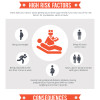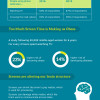
High blood pressure is a worldwide phenomenon that is leading to more individuals developing cardiovascular diseases daily. It can also lead to the development of noncardiovascular diseases such as kidney failure or even brain damage. The unfortunate thing with high blood pressure, however, is that it usually progresses without any symptoms until the damage is already done. Because of this, it is important to know your blood pressure and take the necessary steps to get it under control. One approach to getting your hypertension under control is watching what you consume. While there are certain foods that you can consume » » » [Read more]









